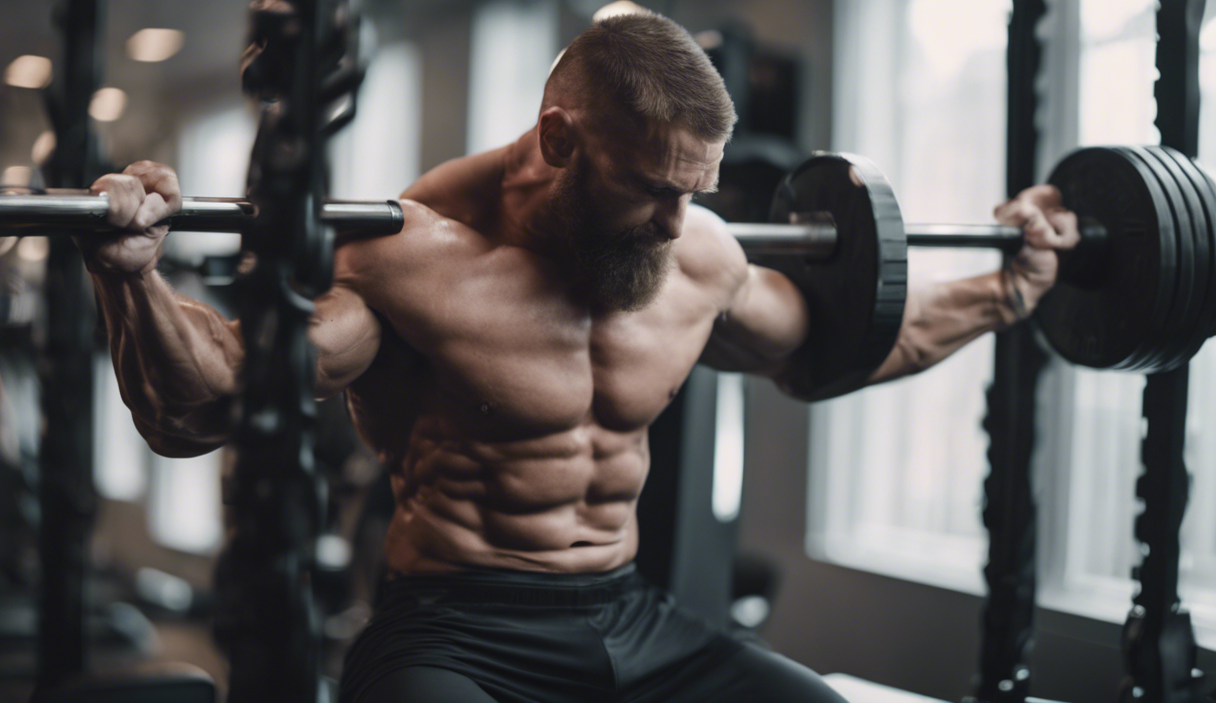Please Note: This post may contain affiliate links. If you click one of them, we may receive a commission at no extra cost to you. As an Amazon Associate, I earn from qualifying purchases.

So, you’ve decided to take your bodybuilding game to the next level.
Congratulations! You’re about to embark on a journey that will not only transform your physique but also turn you into a walking encyclopedia of muscle anatomy—because let’s face it, you’ll start throwing around terms like “latissimus dorsi” at parties, and people will be both impressed and confused.
But first, let’s tackle how to design an effective split routine that can help you build those muscles efficiently.
Top Takeaways and Key Concepts
Choose a split routine that fits your schedule to train specific muscle groups efficiently.
Start each workout with compound exercises to build strength before isolation moves.
Use 8–12 reps and 3–5 sets to build muscle with moderate weight and good form.
Apply progressive overload weekly by increasing weight, reps, or sets over time.
Fuel training with balanced nutrition and prioritize rest to support muscle growth.
Summary of This Article
This article explains how to design an effective bodybuilding split routine to maximize muscle growth and training efficiency. It covers the purpose of split training, how to choose a split based on weekly availability, and how to structure workouts using compound and isolation exercises. The article emphasizes the importance of reps, sets, and progressive overload for hypertrophy while also stressing that proper nutrition and recovery are essential for continued progress. Overall, it offers a clear road map for building a smart, sustainable muscle-building routine.
Shortcuts to Exercise Equipment Shopping at Amazon
Ellipticals - Exercise Bikes - Recumbent Bikes - Treadmills - Rowers
Dumbbells - Resistance Bands - Kettlebells - Benches - Pull-up Bars
Video Summary
1. Understanding Split Routines
To kick things off, let’s clarify what a split routine is. Picture this: instead of doing a full-body workout every time you hit the gym (which is great for beginners), you’re going to focus on different muscle groups each day. It’s like dividing your laundry into darks and lights; it just makes sense!
Typically, advanced bodybuilders might train three to six days a week with specific splits. This allows more volume and intensity per muscle group while giving others time to recover. I mean, who doesn’t want their biceps looking like they could lift small cars?
By the way, if you’re wondering why this matters—think of your muscles as sponges soaking up all that glorious work. If they’re constantly drenched in sweat without breaks, they won’t grow as effectively. And nobody wants sad little sponges!
2. Choosing Your Split Type
Now that we understand what we’re dealing with, it’s time to choose the right type of split routine for you. There are several popular options out there:
– Upper/Lower Split: You hit upper body one day and lower body the next.
– Push/Pull/Legs: One day focuses on pushing movements (chest/triceps), another on pulling (back/biceps), and then legs.
– Body Part Split: Each workout targets one or two specific muscle groups.
Honestly speaking? The choice depends on how many days per week you’re willing or able to commit! If you’re training four days a week, an upper/lower split works wonders. However, if you have more time—and let’s be real here—more energy than I do before my morning coffee, go for push/pull/legs!
3. Structuring Your Workouts
Let’s see…once you’ve settled on your split type, it’s time to structure those workouts! A good rule of thumb is starting with compound movements followed by isolation exercises.
For example:
– On chest day (let’s say it’s push day), begin with bench presses and incline dumbbell presses—these are big hitters!
– Follow up with some tricep extensions or cable flyes for extra pumpage.
And remember: don’t skip warm-ups! Think of them as your friendly neighborhood superhero cape; they might look silly but protect you from injury while making everything easier.
4. Reps and Sets Galore
Next up: reps and sets! Ah yes—the age-old question: how many times should I lift this heavy thing? For hypertrophy—or muscle growth—you’ll want to aim for moderate weights at higher reps (8-12) across multiple sets (3-5).
But wait! As a matter of fact, mixing in heavier low-rep sets occasionally can shock those muscles into new growth too! Consider pyramid training where you increase weight while decreasing reps over successive sets—it’s like climbing Mount Everest but less cold.
Also interestingly enough: don’t forget about rest periods between sets! Typically resting 60–90 seconds lets those hardworking muscles recover just enough without losing momentum.
5. Incorporating Progressive Overload
Speaking of momentum… let’s chat about progressive overload because this concept is crucial in bodybuilding success! Essentially, it means gradually increasing stress placed upon the body during exercise training.
This could involve lifting heavier weights each week or adding more reps/sets over time—basically making things progressively harder so your muscles don’t get lazy lounging around watching Netflix all day!
I think keeping track of these changes helps maintain motivation too; seeing progress written down feels much better than trying desperately not to cry when looking at yourself in the mirror after leg day.
6. Nutrition Matters Too!
While working out is essential for building strength and size—it would be remiss not mentioning nutrition here! Think of food as fuel; without high-quality ingredients powering our engines (or bodies), we won’t perform optimally no matter how fancy our routines are!
Ensure adequate protein intake post-workout helps repair those micro-tears caused by lifting heavy stuff—all part of the glorious process known as “gains.” Aim for lean meats like chicken or turkey breast along with plenty of fruits and vegetables—we need vitamins too!
And hey—don’t underestimate carbs either—they provide energy needed during intense workouts because nobody likes feeling sluggish halfway through squats!
7. Listen To Your Body
Lastly—but certainly not least—always listen closely when your body speaks up! Sometimes it whispers sweet nothings encouraging us through tough sessions; other times it screams “STOP!” due to fatigue or potential injury risks lurking nearby.
Rest days aren’t just recommended—they’re mandatory if we want sustainable gains over long periods rather than risking burnout faster than my enthusiasm wanes after realizing I’ve eaten too much cake again…
So, keep communication open between mind & body; knowing when something feels “off” could save weeks spent nursing injuries back into shape later down line!
Suggested Resources:
The Ultimate Guide to Bodybuilding Nutrition
https://www.bodybuilding.com/content/the-ultimate-guide-to-bodybuilding-nutrition.html
How To Create a Workout Plan That Works for You
https://www.muscleandstrength.com/articles/how-to-create-a-workout-plan-that-works-for-you
Progressive Overload – The Key to Muscle Growth
https://www.t-nation.com/training/progressive-overload-the-key-to-muscle-growth
Frequently Asked Questions
What is a split routine in bodybuilding?
A split routine divides training sessions by muscle group so each area gets more focused volume and recovery time than a full-body workout approach.
How many days per week should I train on a split?
Most advanced lifters train three to six days per week depending on schedule, recovery ability, and training goals.
Which split style is best for muscle growth?
Upper/lower and push pull legs splits are most commonly used because they balance intensity, frequency, and recovery for long term progress.
Why start workouts with compound exercises?
Compound lifts target multiple muscle groups at once and allow heavier loads, which stimulates greater overall strength and hypertrophy.
How many reps and sets should I use for hypertrophy?
Moderate weight for eight to twelve reps across three to five sets is widely used to maximize muscle building stimulus.
What is progressive overload and why does it matter?
Progressive overload means gradually increasing weight, reps, or sets so muscles continually adapt instead of plateauing.
Does rest and nutrition impact split routine results?
Adequate sleep, protein intake, and recovery days are essential because muscle growth happens outside the gym between sessions.

Kevin Collier is a passionate fitness expert dedicated to helping individuals achieve their health and wellness goals. With a focus on weight lifting, exercise routines, and effective weight loss strategies, he aims to inspire and motivate others on their fitness journeys. Through evidence-based insights and practical advice, Kevin empowers readers to make informed decisions about their health, encouraging a balanced approach to fitness and overall well-being. Whether you’re a beginner or an experienced athlete, his expertise offers valuable guidance to elevate your fitness game.




